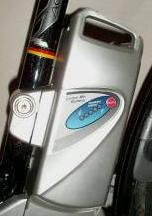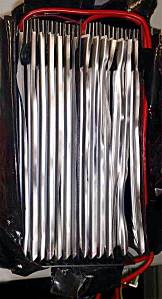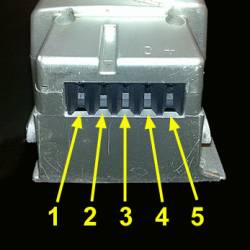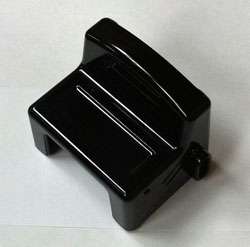27.9.2010
.
.
Panasonic Lithium Polymer Battery
Most common are 8 and 10 Ah batteries, but Panasonic have introduced a 15 Ah battery now. Unfortunately this requires modifications to the unit that bar the use of the smaller sizes subsequently. BMZ alternatives are available now through suppliers of Derby Cycles makes like Kalkhoff etc and these are in 8, 12 or 18 Ah sizes, both fitting into existing models. When a battery or new e-bike is received, the battery will normally be partly charged, but the temptation to use it straight away should be resisted. It should first be fully charged before use and then subjected to two conditioning cycles.
After connecting the battery to either the supplied base charger or the optional extra portable charger and switching on, the LED display on the battery lights step by step as the charge progresses. However, when the fifth LED lights the battery is not full, it's just commencing the last phase of charging which lasts for around an hour at which point all the LEDs extinguish and the charge is then complete.
Conditioning has two purposes, the first equalises the charge in the electrolyte throughout the battery cell contents, the second sets the five LED meter zero point to ensure accuracy of readout. To condition the battery it should first be fully charged, then used until almost empty, and for a new battery this process should be repeated twice. For the first of these conditioning cycles the usage can be down to the first slow flashing stage shown on the handlebar meter, but it's important that the second conditioning usage is down to the second and fast flashing stage for the meter zero to be correctly reset. Failing to do that could lead to inaccurate subsequent content and capacity readouts. Of course when using the battery in one of those discharge cycles it's wise to return fairly close to home once the slow flashing stage commences so as not to leave you a long unpowered ride, especially if in a hilly area.
The charge meter on the battery shows the charge content when the test button is briefly pressed, each step on the LED display showing roughly 20% of the content. For obvious reasons there isn't an exact correspondence of the three LED handlebar display with the more accurate five LED battery display, the handlebar one meant to provide a rough guide to the current state whie riding . The accuracy of the battery meter can drift out over time, the rate at which this happens being tied to the frequency of use. A regularly used battery will maintain the accuracy for some months, but an intermittently used one can lose accuracy in much less time, particularly if the battery enters the sleep mode, details of which are linked to at the head of this page. In all cases where inaccuracy is known or suspected, the battery should be given one full conditioning cycle with the discharge stage taken down to the fast flashing mode to return the meter to full accuracy. See also Cold Weather Effects.
To perform a capacity check, press and hold the battery test button for a minimum of five seconds, after which the capacity of the battery to contain charge content quantity is shown on the five LEDS, each representing 20% of the capability. If the ability appears lower than expected, it's likely that the LED meter has drifted out of registration. It then needs to be re-zeroed by doing a full conditioning cycle with the usage stage down to the fast flashing stage to restore accuracy. See also Cold Weather Effects.
The Panasonic batteries only have a sleep mode which disconnects the internal Battery Management System (BMS), cutting out the slight continuing discharge through the BMS over time when the battery is not in use. A fully charge battery if left unused will go into sleep mode after approximately four months, while a 50% charged battery will go into sleep mode after about two weeks, the time of in-between charges going into sleep mode being between those in proportion to the amount of stored charge. To bring a battery out of sleep mode it must be recharged, but the accuracy of it's LED metering has been lost through going into the sleep state. Therefore a full conditioning cycle with the discharge stage down to the fast flashing mode is necessary to return the meter to subsequent accuracy for both content and capacity checks.
Having an automatic storage mode means one of these batteries can be safely stored almost indefinitely since lithium cells do not suffer from self-discharge. Any discharge is only due to the very slight current leakage through the internal BMS (Battery Management System) which is disconnected during sleep mode. However, the content of a battery cell is still subject to continuing chemical activity over time which ages it, so it's unwise to buy a battery many months or a year in advance of when it might be needed, unless any special offer value occurring outweighs the time disadvantage.
A premature fault is extremely rare with one of these advanced batteries, in case after case of suspected faults a full conditioning cycle returns the battery to full health and capacity. Therefore, that should always be done before taking any further action.
Cold Winter weather affects both the battery and the accuracy of a capacity check. The range is reduced by approximately 10% as the temperature approaches or drops below zero degrees centigrade, due to the slowing of the cell chemical reactions with falling temperature. This also affects the capacity check which can drop to 80% on a perfectly good battery. Doing a full conditioning cycle to compensate for that will correct the capacity check accuracy, but it's hardly worth doing in that circumstance since continuing cold will drop the reading again. Doing a full conditioning cycle when higher temperatures eventually return will correct the readout of capacity.
After connecting the battery to either the supplied base charger or the optional extra portable charger and switching on, the LED display on the battery lights step by step as the charge progresses. However, when the fifth LED lights the battery is not full, it's just commencing the last phase of charging which lasts for around an hour at which point all the LEDs extinguish and the charge is then complete.
Conditioning has two purposes, the first equalises the charge in the electrolyte throughout the battery cell contents, the second sets the five LED meter zero point to ensure accuracy of readout. To condition the battery it should first be fully charged, then used until almost empty, and for a new battery this process should be repeated twice. For the first of these conditioning cycles the usage can be down to the first slow flashing stage shown on the handlebar meter, but it's important that the second conditioning usage is down to the second and fast flashing stage for the meter zero to be correctly reset. Failing to do that could lead to inaccurate subsequent content and capacity readouts. Of course when using the battery in one of those discharge cycles it's wise to return fairly close to home once the slow flashing stage commences so as not to leave you a long unpowered ride, especially if in a hilly area.
The charge meter on the battery shows the charge content when the test button is briefly pressed, each step on the LED display showing roughly 20% of the content. For obvious reasons there isn't an exact correspondence of the three LED handlebar display with the more accurate five LED battery display, the handlebar one meant to provide a rough guide to the current state whie riding . The accuracy of the battery meter can drift out over time, the rate at which this happens being tied to the frequency of use. A regularly used battery will maintain the accuracy for some months, but an intermittently used one can lose accuracy in much less time, particularly if the battery enters the sleep mode, details of which are linked to at the head of this page. In all cases where inaccuracy is known or suspected, the battery should be given one full conditioning cycle with the discharge stage taken down to the fast flashing mode to return the meter to full accuracy. See also Cold Weather Effects.
To perform a capacity check, press and hold the battery test button for a minimum of five seconds, after which the capacity of the battery to contain charge content quantity is shown on the five LEDS, each representing 20% of the capability. If the ability appears lower than expected, it's likely that the LED meter has drifted out of registration. It then needs to be re-zeroed by doing a full conditioning cycle with the usage stage down to the fast flashing stage to restore accuracy. See also Cold Weather Effects.
The Panasonic batteries only have a sleep mode which disconnects the internal Battery Management System (BMS), cutting out the slight continuing discharge through the BMS over time when the battery is not in use. A fully charge battery if left unused will go into sleep mode after approximately four months, while a 50% charged battery will go into sleep mode after about two weeks, the time of in-between charges going into sleep mode being between those in proportion to the amount of stored charge. To bring a battery out of sleep mode it must be recharged, but the accuracy of it's LED metering has been lost through going into the sleep state. Therefore a full conditioning cycle with the discharge stage down to the fast flashing mode is necessary to return the meter to subsequent accuracy for both content and capacity checks.
Having an automatic storage mode means one of these batteries can be safely stored almost indefinitely since lithium cells do not suffer from self-discharge. Any discharge is only due to the very slight current leakage through the internal BMS (Battery Management System) which is disconnected during sleep mode. However, the content of a battery cell is still subject to continuing chemical activity over time which ages it, so it's unwise to buy a battery many months or a year in advance of when it might be needed, unless any special offer value occurring outweighs the time disadvantage.
A premature fault is extremely rare with one of these advanced batteries, in case after case of suspected faults a full conditioning cycle returns the battery to full health and capacity. Therefore, that should always be done before taking any further action.
Cold Winter weather affects both the battery and the accuracy of a capacity check. The range is reduced by approximately 10% as the temperature approaches or drops below zero degrees centigrade, due to the slowing of the cell chemical reactions with falling temperature. This also affects the capacity check which can drop to 80% on a perfectly good battery. Doing a full conditioning cycle to compensate for that will correct the capacity check accuracy, but it's hardly worth doing in that circumstance since continuing cold will drop the reading again. Doing a full conditioning cycle when higher temperatures eventually return will correct the readout of capacity.
Technical Details
The photo at the right shows the internal cell pack of the 10 Ah battery opened up. There are 14 cells each of a nominal 3.7 volts and 5 Ah capacity, arranged as two series banks each of 7 cells, the two banks wired in parallel to give a nominal 25.9 volts at 10 Ah.
The cells are lithium polymer and soft cased in metallised plastic. The internal battery management system (BMS) has reverse polarity protection and will not be charged if connected to a second battery in parallel. The complete 10 Ah battery weighs 2.3 kilograms.
The battery blade type connections shown in the photo below are:
The photo at the right shows the internal cell pack of the 10 Ah battery opened up. There are 14 cells each of a nominal 3.7 volts and 5 Ah capacity, arranged as two series banks each of 7 cells, the two banks wired in parallel to give a nominal 25.9 volts at 10 Ah.
The cells are lithium polymer and soft cased in metallised plastic. The internal battery management system (BMS) has reverse polarity protection and will not be charged if connected to a second battery in parallel. The complete 10 Ah battery weighs 2.3 kilograms.
The battery blade type connections shown in the photo below are:
1) Charge monitoring, presumably by temperature.
2) Negative (-)
3) Battery Meter.
4) Charging Positive (+)
5) Output Positive (+)
2) Negative (-)
3) Battery Meter.
4) Charging Positive (+)
5) Output Positive (+)
It can be seen that the negative connector (2) is stepped, presumably to prevent the travel charger's plug-on connector pad being attached with connections reversed.




A terminal cover is now available for those occasions when the battery is out of the bike for charging, security reasons, or simply when used without the battery. This fits snugly into the unit and protects the unit's terminals from water and other deposits that might corrode them.